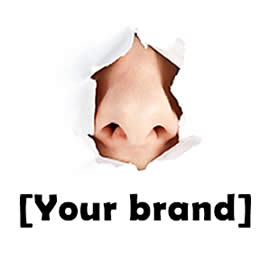Why You Need a Scent Logo
Guest Post by Jennifer Dublino
 All marketers are familiar with the concept of a logo, a visual representation of a brand. Some, like Coca Cola, Disney, Apple and Nike are so iconic that exposure to them, even when they aren’t noticed, affects our behavior. For these large companies with their massive marketing budgets, it is fairly easy to expose large numbers of people to their logo and brand identity. As a result, their brand recall is close to 100% throughout a good part of the world.
All marketers are familiar with the concept of a logo, a visual representation of a brand. Some, like Coca Cola, Disney, Apple and Nike are so iconic that exposure to them, even when they aren’t noticed, affects our behavior. For these large companies with their massive marketing budgets, it is fairly easy to expose large numbers of people to their logo and brand identity. As a result, their brand recall is close to 100% throughout a good part of the world.
But what about small and medium-sized companies? The average person is exposed to up to 5,000 ads a day. How can you get customers to remember your brand with all this clutter?
The surprising answer is through the sense of smell.
The sense of smell is the only one of our five senses that is directly connected to the part of the brain that processes emotion, memory and associated learning. In fact, you are 100 times more likely to remember something that you smell than something that you see, hear or touch.
Savvy marketers utilize this fact by creating an olfactory logo for their business. An olfactory logo, also called scent branding, is a custom scent that the brand creates to embody its unique brand characteristics. Much like a graphic logo, the olfactory logo is used wherever the brand is present. After repeated exposures to the olfactory logo, the smell becomes strongly associated with that brand.
In order to work, the signature scent needs to be consistent with the image and emotions of the brand. Think about the personality of your brand. Is your brand reliable and trustworthy or edgy and fun? Is your brand relaxed or power charged? Also think about your target market. Are they young, middle-aged or older? Predominantly male or female? Value or luxury buyers? These characteristics can be successfully matched with different fragrance elements to create a scent that embodies your brand characteristics.
A highly successful use of scent branding is Abercrombie & Fitch. Their signature fragrance, Fierce, is dispersed in high concentrations in all of their stores. Fierce is strong, edgy and appeals to young, upscale consumers. The result? Fierce (which is also sold as a personal fragrance) is the number one selling fragrance for men in the US and Europe and A&F’s teenage and young adult target market can easily identify authentic A&F jeans solely by their smell.
Most of the major hotel chains also use an olfactory logo. For example, the Westin uses a cool and relaxing white tea fragrance, and the St. Regis uses an elegant blend of rose, sweet pea and pipe tobacco.
Once you have created your signature scent, use it in every possible customer touchpoint, so that it can become associated closely with your brand in the customer’s mind. If you have a hotel, store, spa or other location for your business, you can use a scent diffuser to disperse the fragrance in the air. Companies producing packaged goods can incorporate the scent into their packaging. Then, to spur repeat sales, use the scent in direct mail to remind customers of their positive experience with your brand.
Before you know it, your brand will be top of mind, and the aroma you detect will be the sweet smell of success!
